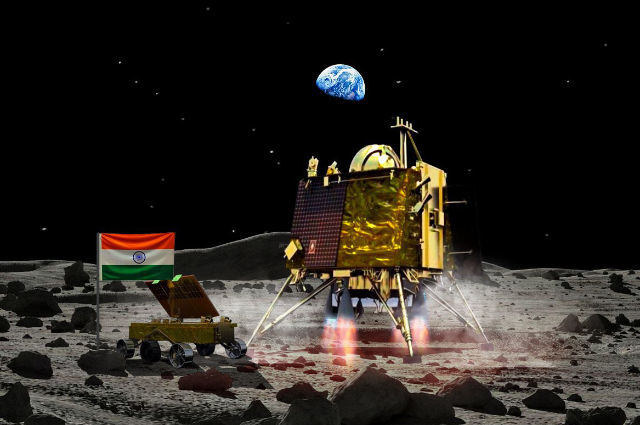I. INTRODUCTION
India’s space program, known as the Indian Space Research Organization (ISRO), has evolved from its humble beginnings in the 1960s to become a global player in space exploration. With a strong focus on cost-effectiveness, ISRO has achieved remarkable milestone, such as launching the Mars Orbiter Mission at a fraction of the cost of similar missions by other nations. India’s space endeavors encompass not only planetary exploration but also an extensive satellite program that has bolstered telecommunications, weather forecasting, and disaster management. As ISRO continues to advance, it embodies a remarkable blend of technological innovation, economic pragmatism, and a commitment to expanding our understanding of the cosmos.
These groundbreaking endeavors, spearheaded by the Indian Space Research Organization (ISRO), have captivated the world’s imagination with their audacious quests to explore the mysteries of Earth’s celestial neighbor, the Moon. With cutting-edge technology and unwavering determination, Chandrayaan missions have unveiled lunar secrets, from water ice deposits to ancient lunar history, propelling India into the forefront of space exploration and leaving an indelible mark on our understanding of the cosmos.
II. HISTORICAL CONTEXT
India’s space program, which traces its roots back to the early 1960s, is a remarkable journey through time and innovation. From the launch of its first satellite, Aryabhata, in 1975, to the Mars Orbiter Mission’s triumphant arrival at the Red Planet in 2013, India’s space agency, ISRO, has defied odds and expectations. With a blend of ancient knowledge and cutting-edge technology, India has emerged as a major player in the global space arena, demonstrating its ability to harness the vast potential of space exploration for both scientific advancement and socio-economic development.
The early lunar missions by other countries, such as Apollo by the United States and Luna by the Soviet Union, marked extraordinary feats of human achievement, as they ventured beyond Earth’s boundaries to explore the mysterious and desolate landscape of our closest celestial neighbor, the Moon. These audacious endeavors not only expanded our scientific understanding of space but also captured the world’s imagination, inspiring generations to reach for the stars and dream of a future where humanity might one-day call other worlds home.
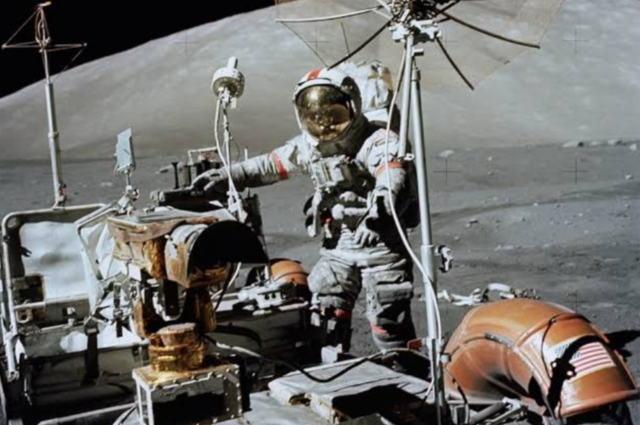
Image by National Geography
India’s motivation for lunar exploration is deeply rooted in both scientific curiosity and strategic aspirations. On one hand, the country seeks to unravel the mysteries of the Moon, aiming to expand our understanding of lunar geology, water resources, and its potential as a stepping stone for future space missions. On the other hands, this endeavor showcases India’s growing prowess in space technology and bolsters its position on the global stage, exemplifying the nation’s commitment to advancing its space program and fostering international collaboration in the pursuit of space exploration.
III. CHANDRAYAAN – 1: INDIA’S MAIDEN LUNAR MISSION
The Chandrayaan – 1 mission, launched by the Indian Space Research Organization (ISRO) in October 2008, captivated the world’s attention as India’s maiden lunar exploration endeavor. Equipped with cutting-edge instruments, including a Moon Impact Probe and a Moon Impact Probe, Chandrayaan – 1 not only confirmed the presence of water molecules on the Moon’s surface but also made an unexpected discovery of water ice in polar regions. Sadly, communication with the orbiter was lost in August 2009, ending the mission prematurely, but its achievements in advancing our understanding of the Moon’s geology and mineral composition endure as a testament to India’s growing prowess in space exploration.
The objectives and scientific instruments on board this cutting-edge spacecraft not only pave the way for groundbreaking discoveries in astrophysics but also promise to revolutionize our understanding of the cosmos, offering a tantalizing glimpse into the mysteries of distant galaxies and the birth of stars.
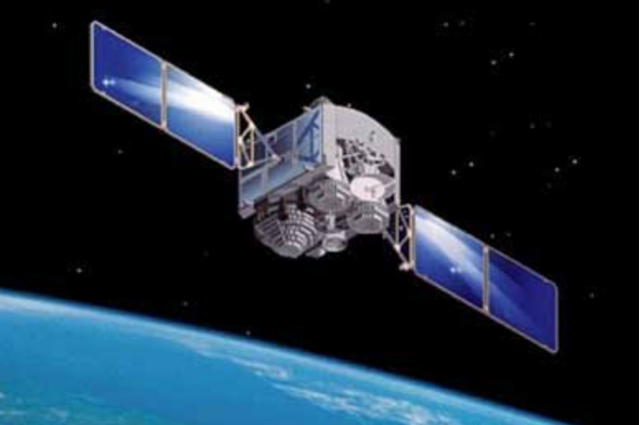
Key discoveries and contributions have shaped the course of human history, from the revolutionary insights of scientific pioneers like Isaac Newton, whose laws of motion unveiled the secrets of the cosmos, to the transformative innovations of visionaries like Steve Jobs, whose Apple products redefined the way we interact with technology. During the mission, a myriad of formidable challenges emerged, ranging from unexpected technical malfunctions that demanded quick thinking and innovative solutions to the relentless psychological strain of isolation and uncertainty, as astronauts grappled with the profound solitude of space and the haunting beauty of Earth from afar, reminding us of the remarkable resilience and determination required to venture beyond our planet’s bounds.
IV. CHANDRAYAAN – 2: ADVANCING INDIA’S LUNAR EXPLORATION
The Chandrayaan – 2 mission, launched by the Indian Space Research Organization (ISRO) in July 2019, captured global attention with its ambitious goal of exploring the Moon’s south polar region, a region shrouded in mystery and scientific intrigue. This remarkable mission included an orbiter, a lander called Vikram, and a rover named Pragyan, collectively designed to conduct a wide range of scientific experiments and lunar exploration.
Chandrayaan – 2, India’s second lunar exploration mission, marked a significant advancement over its predecessor, Chandrayaan – 1. While both missions aimed to study the Moon, Chandrayaan – 2 stood out for its intricate design, consisting of an orbiter, a lander named Vikram, and the Pragyan rover. In contrast, Chandrayaan – 1 consisted of only an orbiter. Although Chandrayaan – 2’s Vikram lander faced challenges during its attempted landing, both missions contributed significantly to our understanding of the Moon, showcasing India’s progress in lunar exploration. The Vikram Lander and Pragyan rover, both integral components of India’s Chandrayaan – 2 mission to the Moon, captured the world’s attention with their ambitious lunar exploration endeavors.
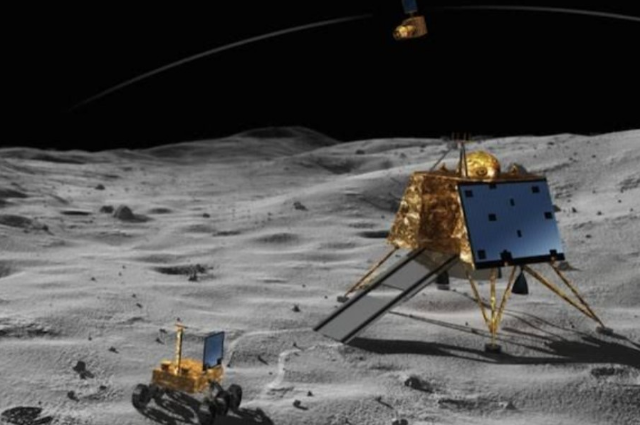
The significance of the orbiter’s continuous operations lies in its ability to unlock invaluable insights into the mysteries of our solar system, providing a continuous stream of data and imagery that fuels scientific discovery, deepening our understanding of distant worlds, and paving the way for future explorations beyond our own planet.
V. SCIENTIFIC DISCOVERIES AND CONTRIBUTIONS
Exploring the lunar water discovery has ignited a new era of space exploration, unveiling the moon’s hidden treasure trove of water ice in its polar regions. This precious resource not only holds the key to sustaining future lunar colonies but also sparks curiosity about the moon’s history and its potential role in humanity’s journey beyond Earth, making it a captivating frontier for scientists and dreamers alike.
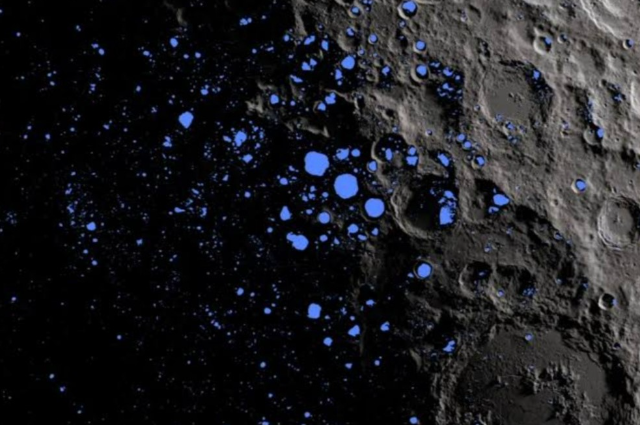
Image by Smithsonia magazine
The Chandrayaan missions have significantly advanced our comprehension of the Moon’s geology and mineral composition. By employing a suite of scientific instruments, including spectrometers and remote sensing devices, these missions have unveiled the Moon’s hidden secrets. They’ve illuminated the presence of water molecules in the lunar soil, identified key minerals like magnesium, iron, and calcium, and provided invaluable insights into its geological history.
VI. INTERNATIONAL COLLABORATIONS AND IMPACT
Engaging in discussions about collaboration with prominent space agencies such as NASA not only opens up exciting possibilities for groundbreaking discoveries but also underscores the imperative of international cooperation in the realm of space exploration. The prospect of pooling resources, expertise, and cutting-edge technology with organizations like NASA ignites curiosity and inspires the pursuit of ventures that extend humanity’s reach into the cosmos, making it a captivating endeavor for both scientists and enthusiasts alike.

VII. CHALLENGES AND FUTURE PROSPECTS
Addressing the challenges faced by India’s space program is akin to navigating uncharted celestial terrain. With its ambitious endeavors like the Chandrayaan and Mangalyaan missions, India has showcased remarkable technological prowess, yet confronting budget constraints, international competition, and the intricacies of interplanetary exploration remain formidable hurdles. Nevertheless, the nation’s unwavering commitment to scientific discovery and its burgeoning role in the global space community make these challenges not only daunting but also intriguing, as they inspire innovation, international collaboration, and a shared vision of reaching for the stars.
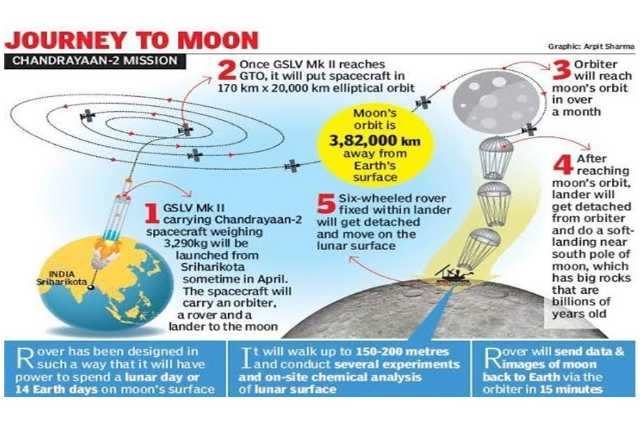
Image by MIT Technology Review
VIII. SUMMING UP
The Chandrayaan missions have left an indelible mark on the landscape of space exploration. Their groundbreaking discoveries and relentless pursuit of lunar knowledge underscore the pivotal role India has assumed in unraveling the mysteries of our celestial neighbor. As we reiterate the significance of Chandrayaan missions, we are reminded that these endeavors not only propel our understanding of the cosmos but also inspire future generations to reach for the stars, fostering a spirit of curiosity and discovery that knows no bounds.

